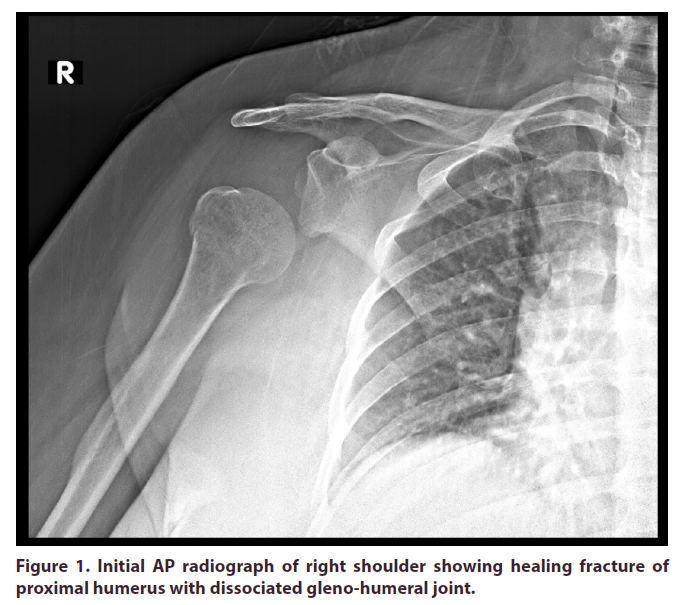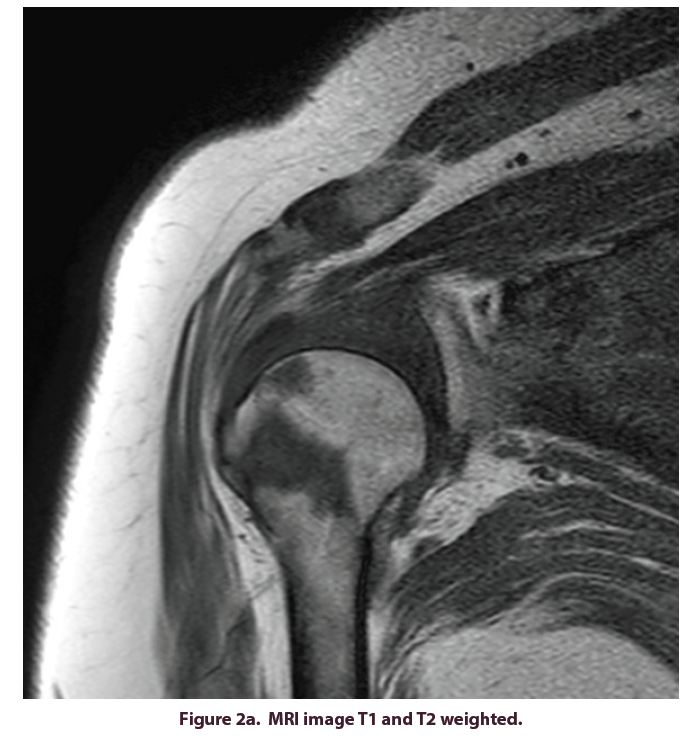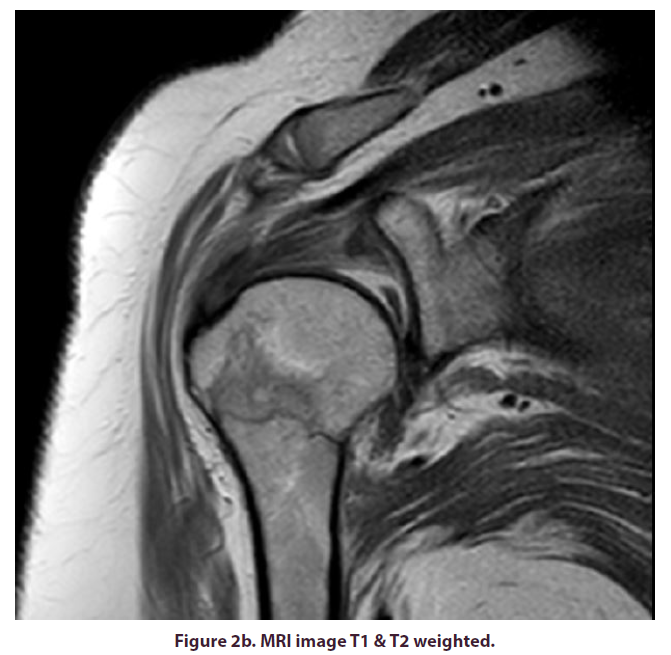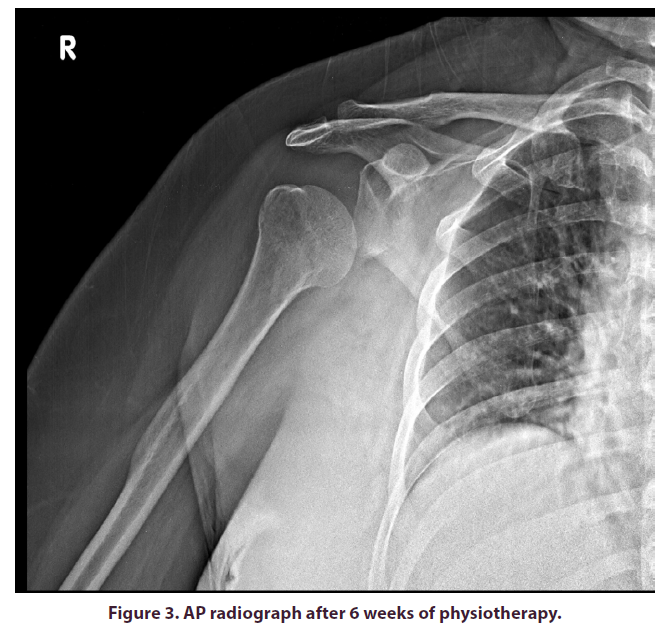Case Report - International Journal of Clinical Rheumatology (2021) Volume 16, Issue 7
Inferior subluxation of humeral head mimicking shoulder dislocation: case report and review of literature
- *Corresponding Author:
- Kirti Mohan Marya
Department of Orthopaedics, Aster Specialist Centre for Orthopaedics and Physiotherapy, Aster DM Healthcare, Dubai, United Arab Emirates
E-mail: drkmmarya@yahoo.com
Abstract
We report a case of 54-year-old female patient who presented with right shoulder pain and stiffness for routine follow -up after having sustained a non-displaced humeral neck fracture. Surprisingly, her X-rays showed completely dissociated glenohumeral joint similar to a dislocation. On further evaluation, it was confirmed to be a case of inferior subluxation of humeral head because of prolonged immobilization and muscular atony. Few weeks of rehabilitation led to full recovery. Physicians working in Accident & Emergency department, as well as radiologists need to be equally aware of this condition to avoid unnecessary diagnostic evaluations and orthopedic maneuvers/ interventions.
Keywords
inferior subluxation • shoulder dislocation
Case Report
A 54-year-old reported in the outpatient department with pain and right shoulder stiffness. She had a history of slip and fall on the affected shoulder about a month prior to this visit and was primarily treated for an un-displaced proximal humeral fracture in Accident & Emergency department of another hospital, where non-operative treatment was initiated. The patient was put on cuff and collar sling and was advised to follow up for routine fracture healing. Clinical examination revealed no neurological deficit. Patient had a BMI of 46.71 and was unable to abduct the arm actively to more than 30°C. She revealed history of constant sitting even while sleeping because of her obesity, discomfort, pain and inability to lie in decubitus position. Once we confirmed her diagnosis, immediate rehabilitation and isometric exercises were initiated under physiotherapist guidance and after 12 weeks, she recovered fully.
Imaging findings
Anteroposterior radiography of the right shoulder demonstrated complete dissociation between glenoid and humeral head with a healing fracture of the humeral neck (Figure 1). The appearance was suggestive of a dislocation that would have required immediate reduction – closed or open. The radiographs were compared to the initial post traumatic images which confirmed absence of any dislocation on initial trauma. Axial view and transthoracic lateral view were taken to assess anteroposterior positioning of humeral head. Given that the patient was obese and could not allow much abduction of the arm, it was difficult to obtain clear imaging studies. MRI studies of the right shoulder revealed healing fracture humeral neck associated with sub-glenoid inferior subluxation with associated sub centimeter sized torn labral fragment (Figure 2a and Figure 2b). No other tear was identified, however features of adhesive capsulitis and partial thickness anterior footprint rim rent tear of supraspinatus tendon and mild subscapularis recess effusion were noted. Follow-up X-rays were taken while elbow was supported, and the subluxation distance improved significantly upon this maneuver (Figure 3).
Discussion
Cotton in 1921 first reported inferior shoulder subluxation after apparently uncomplicated fractures of the humeral neck [1]. Since then, others have reported similar findings in immediate post-fracture period [2, 3]. Inferior subluxation or transitory humeral inferior subluxation of the head of humerus has been reported after shoulder trauma, after operative procedures such as rotator cuff repair, fractures or prosthetic replacement of head of humerus [4]. Static inferior subluxation of the humeral head is often underestimated both by the surgeon and the radiologist at follow-ups of proximal humerus fractures that were surgically treated [3].
Older, female, obese, and osteoporotic patients are more prone to develop it [5]. Hypotonic deltoid and cuff muscles, load of the upper limb in obese patients, and the laxity of the inferior capsule has been suggested as the causative reasons for inferior static subluxation of the humeral head in non-operated cases [4]. According to Dudko et al., [6], impaction of bony fragments and distention of the joint by haematoma are the other two known reasons.
It is important for radiologists to recognize this entity of low riding humeral head and to differentiate it from an actual dislocation as it closely mimics it. An actual dislocation would require immediate attention, definitive assessment of the cause and direction of the dislocation and it would necessitate immediate reduction, whereas an inferior subluxation which generally occurs because of muscle atony and constant gravitational pull with the weight of the extremity, requires early activity and rehabilitation with isometric exercises of the shoulder muscles [5].
In this particular case the prolonged cuff and collar immobilization, weight of arm [obesity], erect decubitus of the patient and lack of exercises led to the humeral head subluxating inferiorly. Pritchett et al., in a series of one hundred consecutive patients, found no patient developed either temporary or permanent symptoms of shoulder instability and concluded this to be a benign, temporary, and asymptomatic condition [4].
Treatment
Treatment of inferior subluxation of humerus requires minimizing vertical humeral traction and supporting the elbow when not exercising and initiating isometric exercises to strengthen the deltoid as well as the rotator cuff muscles [4]. There is no need for surgery or any maneuvers for reduction. As in this case, once the muscle tone returns, the subluxation ceases to occur. Usually, it takes 2 months to 3 for return to normalcy although residual inferior subluxation may persist for even 6 months or more as reported in the literature [7, 8].
Conclusion
Inferior subluxation of humeral head can often mimic a shoulder dislocation. When such a dislocation is associated with a recent traumatic fracture and a brief period of immobilization/cuff collar sling/or a recent surgery of the shoulder, a high index of suspicion should be maintained towards this entity. The importance of identifying this condition is paramount, so as to mitigate unnecessary diagnostic evaluations and reductional maneuvers and/or other procedures that could save the patient and the treating team alike from wasteful time and expenses.
References
- Cotton FJ. Subluxation of the shoulder-downward. Boston. Med. Surg. J. 185, 405–407 (1921).
- Yosipovitch Z, Goldberg I. Inferior subluxation of the humeral head after injury to the shoulder. A brief note. J. Bone. Joint. Surg. Am. 71(5), 751–753 (1989).
- Neer CS 2nd. Displaced proximal humeral fractures. II. Treatment of three-part and four-part displacement. J. Bone. Joint. Surg. Am. 52(6), 1090-1103 (1970).
- Pritchett JW. Inferior subluxation of the humeral head after trauma or surgery. J. Shoulder. Elbow. Surg. 6(4), 356–359 (1997).
- Carbone S, Papalia M, Arceri V et al. Humeral head inferior subluxation in proximal humerus fractures. Int. Orthop. 42(4), 901–907 (2018).
- Dudko S, Wojciechowski P, Kusz D et al. Inferior subluxation of humerus after surgery of fractures of proximal humerus. Chir. Narzadow. Ruchu. Ortop. Pol. 67(2), 175–-180 (2002.
- Aufranc OE, Jones WN, Turner RH et al. Humeral neck fracture with inferior subluxation of the shoulder joint. JAMA. 195(5), 380–382 (1966).
- Furuhata R, Matsumura N, Tsujisaka R et al. Risk factors and prognosis of humeral head inferior subluxation in proximal humeral fractures after osteosynthesis. JSES. Int. 5, 739–744 (2021).






